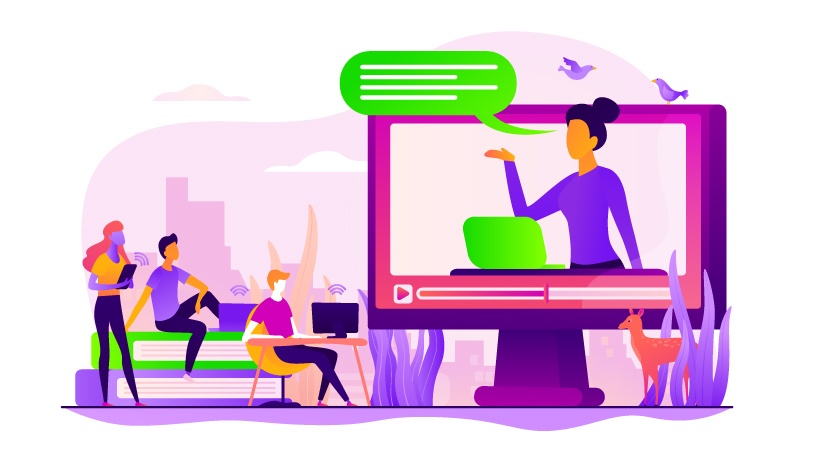What Is Impacting Efficient Learning Environments
Turbulent times are not helping, but challenges which we may face are not really connected to the urge of shaping the learning space in the new way we experience nowadays. These challenges are much more universal and related to:
- The way all learning actors understand, act, and participate in the learning experience.
- The way an organization understands and fulfills its role in the learning space.
- The way learning function builds and leverages on its maturity.
- The way technology is being leveraged with the goal to improve the efficiency of the learning processes.
...to mention only a few.
To better understand what kind of forces are impacting efficient learning environments, we researched various trends, ideas, and concepts. The consolidation of these thoughts let us prepare the "Framework of Efficient Learning Environment," discussed below.
Framework
The framework discusses two forces: one which drives an efficient learning environment (enablers) and the second one which hampers it (derailers). There are two angles covered: learning mindsets and learning experiences for each of these forces. An additional layer related to the impact of the modern learning function on the efficiency of the learning space has been added to make this picture more complete.
Learning Mindsets
Learning mindsets are being impacted from both an organizational and individual perspective. This is us, the people who are the “owners” of these mindsets; but, we can not forget about the corporate context in which these mindsets should find space for growth.
There are many organizational barriers that can limit this space. Rigid structures, unprepared or inadequate learning infrastructure, and obstructing leaders are only examples of these "derailers." Not to mention the resistance to change, which may come from the outside or inside of an organization, and be a representation of the natural behavior of people which has to be overcome by deliberate actions on the corporate level.
Fortunately, organizations with a truly agile learning approach, supported by sensible executive sponsorship actions, orchestrating the transition from an old learning environment to a new one could push the organization in the right direction. Clear communication, engaged advocacy, and integrated leadership are examples of these moves. What is also encouraging in the journey to create an efficient learning environment is the natural human tendency to grow. Leveraging heutagogy and allowing people to have the autonomy, capacity, and capability to learn in a self-determined way can help make great progress in this area in a democratized, bottom-up approach.
Learning Experiences
There are three extremely powerful ideas shaping an efficient learning environment from the perspective of a learning experience. The most mature one is blended learning, which supports the learning environment with a variety of learning modalities (e.g., online, remote interactions with trainers and peers, traditional classroom methods) composed in a deliberate way.
Another one is adaptive learning, which helps the “me” to learn based on "what I know" and "how I learn" by creating a personalized learning experience that adjusts itself based on an individual’s learning needs. The last one is related to bringing learning moments closer to the regular tasks of an employee. Learning in the "flow of work" usually leverages microlearning techniques delivered through various, usually informal, learning experiences supported by line managers and peers.
These three ideas can also fall into organizational or human-related pitfalls which may negatively impact the creation of a conducive learning environment. Lack of content strategies manifested by disaggregated content with generalized learning objectives and learning assets delivered in a random way heavily reduces meaningfulness and relevance of engagement in the learning process. Thinking about adult learners, we cannot forget about the concept of “andragogical distance.”
It can be described as the misalignment of interpretations by different participants of a learning activity, which is usually the result of the implementation of new forms of learning in the development process. And speaking about new forms of learning, we must remember that the creation of truly integrated learning environments, covering learning platforms, learning devices, social learning tools, and hosted on network and connectivity infrastructure, is not an easy task.
Learning Function
A well-prepared and managed learning function should support enablers and reduce the impact of derailers. The growing capability of new learning technologies (like big data, AI, mobile) can help in this endeavor, but it seems that even more important is the set-up of a learning organization with its governance, team structure, roles distribution, etc. What is also critical is to focus on a conducive learning culture in an organization. None of these ideas can be created without the engagement of organizational supporting forces (which we can call “Extended Learning Function”), which is constituted of line managers, business sponsors, leadership, the IT department, HR, marketing, etc.
Summary
A more detailed picture of the above thoughts is included in this deck available on the Slideshare. We must bear in mind that the presented framework is not showing the full picture, we can expect more driving forces in both the positive and negative space of the creation of an efficient learning environment. We hope, however, that we managed to put in the spotlight the most prominent ones which will help you look at your corporate learning environment from an untouched perspective and make substantial improvements in the journey to its efficiency.

